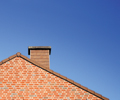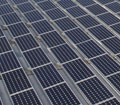Roofing workers often are confronted with some fairly obvious and significant health and safety hazards, such as working at great heights or operating powered equipment. A lesser known roofing industry hazard is electromagnetic radiation; however, the effects of this hazard can be debilitating.
RF energy
Electromagnetic radiation consists of electric and magnetic energy waves moving through space at the speed of light. The range of such energy's wavelengths makes up the electromagnetic spectrum.
Many antennae located on roof systems emit radio waves or microwaves that are collectively referred to as radiofrequency (RF) energy or radiation. The electromagnetic spectrum's RF portion consists of wavelengths with frequencies of 3 kilohertz (kHz)—or 3,000 cycles per second—to 300 gigahertz (GHz)—or 300 billion cycles per second. Microwave frequencies range from 1 GHz to 300 GHz.
RF energy or radiation often is referred to as non-ionizing radiation. Radiation is considered ionizing if it can strip electrons from atoms or molecules—a process of molecular change that can damage biological tissues, according to the U.S. Federal Communications Commission (FCC). Examples of ionizing radiation include X-rays and gamma rays.
In contrast, non-ionizing radiation does not have a sufficient level of energy to strip electrons the same way. However, RF radiation at microwave frequencies that is transferred to water molecules can generate heat. This so-called "thermal effect" can be deadly when human tissue is exposed to high levels. High RF intensities can severely affect areas of the human body—such as the eyes—that have limited ability to dissipate heat. More research must be conducted to determine the health effects of lower RF levels.
Common sources of RF energy—including radio and television broadcasting; cellular and cordless telephones and pagers; personal communication services; business and amateur radio; radio communications for police and fire departments; microwave point-to-point links; and satellite communications—typically pose no threat to the general public. However, because building maintenance personnel, electricians and roofing workers often perform work in close proximity to some components that transmit high levels of RF energy, they are at greater risk.
Related standards
The Occupational Safety and Health Administration has published construction industry standards regarding ionizing and non-ionizing radiation in 29 CFR 1926.53 and 29 CFR 1926.54, respectively. The rules relate primarily to operating laser equipment but also prohibit employee exposures to microwave densities exceeding 10 milliwatts per square centimeter.
Additionally, consensus standard ANSI/IEEE C95.1, Standard for Safety Levels with Respect to Human Exposure to Radio-Frequency Electromagnetic Fields, 3 kHz to 300 GHz (Revised 2005), contains recommendations developed to protect against electric, magnetic and electromagnetic frequencies in the RF spectrum (except for those implemented by medical professionals). More information about the standard is available at www.ansi.org or www.ieee.org.
Protect your employees
The FCC notes that warning signs should be used at locations where workers could be exposed to RF energy. Warning signs should be posted in prominent places so workers are aware of the nature of the RF field, methods that can be employed to avoid exposure, and contact information for the company or person in charge of the transmitter.
However, warning signs may not always accompany transmitters, and you should be vigilant in attempting to determine the nature of rooftop devices that may present RF exposure hazards for your employees.
Harry Dietz is NRCA's director of risk management.



